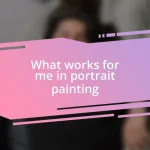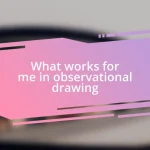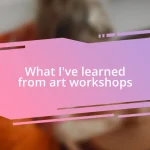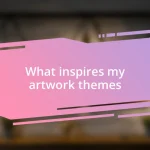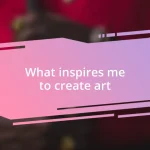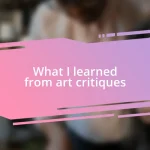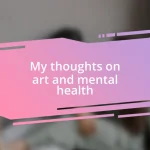Key takeaways:
- Art critique sessions foster vulnerability and diverse perspectives, enriching the artist’s understanding of their work.
- Preparing effectively for critiques includes setting goals, gathering materials, and inviting constructive feedback from trusted peers.
- Implementing feedback involves reflecting on critiques, prioritizing relevant suggestions, and setting specific goals for future art projects to enhance creativity.

Understanding Art Critique Sessions
Art critique sessions can feel like a rollercoaster of emotions, can’t they? I remember my first experience; I sat there, palms sweaty, as I awaited feedback on my piece. The room was filled with anticipation. It was then that I realized these sessions are not just about evaluating art, but about embracing vulnerability and learning from each other.
What strikes me most about these sessions is the diverse perspectives that emerge. Each artist brings their unique lens, and suddenly, your work is viewed through countless viewpoints. I think about a time when someone pointed out a subtle detail in my work that I hadn’t even considered. It changed how I approach my art forever. Isn’t it fascinating how a few words can shift your entire understanding of your own creation?
Moreover, I’ve learned that the tone and delivery of critiques matter significantly. When critiques are constructive and supportive, they foster an environment conducive to growth. I once participated in a critique where the facilitator emphasized the “sandwich method” – positive feedback, constructive criticism, and then something to uplift. It not only eased my anxiety but also encouraged honest conversations. How have your experiences shaped your perspective on receiving feedback?

Preparing for Art Critiques
Preparing for art critiques often requires a blend of mental preparation and logistical organization. I’ve found that setting clear goals is essential; understanding what feedback I need helps focus the critique. The first time I prepared for a critique, I realized I had to articulate my intentions behind the piece clearly. This made a huge difference in how others perceived my work.
Here’s a quick checklist that has always guided me:
- Reflect on your artwork: What aspects are you proud of? What parts do you feel need improvement?
- Gather your materials: Ensure you have your artwork and any supporting documentation, like sketches or a project statement.
- Invite trusted peers: Surround yourself with people who provide constructive feedback and make you feel comfortable.
- Prepare specific questions: Think about what you want to ask; this invites targeted feedback and engaging discussions.
- Practice your presentation: Articulating your thoughts can ease anxiety and help clarify your vision.
By having these strategies in place, I’ve transformed my initial dread into a more empowering experience, allowing me to embrace critiques as opportunities for growth.

Communicating Your Artistic Vision
When it comes to communicating your artistic vision during critique sessions, clarity is paramount. I’ve discovered that sharing the story behind my artwork often resonates deeply with others. For instance, I once presented a piece inspired by my travels. Instead of diving straight into the critique, I took a moment to explain the emotions each element evoked. It was incredible to see how the audience connected with my experiences, allowing them to understand my choices on a different level.
Moreover, inviting questions can significantly enhance the dialogue. During one critique, I encouraged my peers to ask anything that puzzled them about my work. This simple shift created a dynamic conversation that opened up more profound insights. I remember a moment when someone asked about a seemingly random color choice I made; it led to a rich discussion about symbolism and perception that I hadn’t anticipated. Isn’t it amazing how a genuine inquiry can uncover layers of meaning in art?
Lastly, I’ve learned the value of being open to interpretation. Each viewer brings their unique viewpoint, and that enriches the critique process. In one memorable session, a colleague saw a narrative in my art that I never intended but found profoundly poetic. It reminded me that art is a shared experience; my vision is just one piece of the puzzle. Ultimately, embracing this collaborative spirit fosters deeper connections and appreciation for the artistic journey.
| Artistic Communication Strategies | Impact on Critique Sessions |
|---|---|
| Storytelling | Creates emotional connections and a better understanding of intentions. |
| Inviting Questions | Facilitates dynamic discussions and uncovers deeper insights about the artwork. |
| Openness to Interpretation | Encourages diverse perspectives, enriching the critique experience for everyone involved. |

Receiving Feedback Constructively
When it comes to receiving feedback constructively, I’ve found that approaching the critique with an open mind is essential. I vividly remember one particular session where I felt defensive about my work at first. However, as I listened to the feedback, I realized the critiques were aimed at helping me grow rather than tearing me down. Isn’t it interesting how our mindset can either close off or open up opportunities for improvement?
I also try to separate my identity from my artwork when absorbing critiques. This was a tough lesson for me—I once received a piece of feedback that felt very personal, and I struggled for a moment. But I reminded myself that critiques are about the work, not me as an artist. This mental shift helped me take criticism as a stepping stone rather than a roadblock. Isn’t it fascinating how our thoughts can create barriers to our growth?
One technique I’ve adopted is to actively repeat back what I hear in my own words. During one critique, after a peer offered some suggestions, I paraphrased their points to confirm my understanding. This not only clarified their feedback for me but also showed them that I valued their perspectives. I believe this practice fosters a richer dialogue during critiques. Have you ever tried reflecting back feedback? It can be a simple yet powerful tool in transforming how we engage with criticism.

Engaging with Critics Effectively
Engaging with critics effectively requires creating a safe space for dialogue. I remember sitting in a critique where nerves were high, and the tension was palpable. By starting with a light-hearted icebreaker, I noticed how it instantly relaxed the atmosphere, making everyone feel more comfortable to share their thoughts honestly. Isn’t it incredible how a touch of humor can transform a potentially intimidating environment into a collaborative one?
Listening actively is key in these settings. During one memorable session, a critic made a remark about my use of negative space. Instead of immediately defending my choice, I paused and really listened to their perspective. That moment opened a floodgate of inspiration for me, making me see my art in a new light. Have you ever experienced a moment like that, where stepping back allowed you to delve deeper into your own work?
I also find that expressing gratitude for feedback, regardless of its nature, can change the critique dynamic. I once thanked a critic who offered tough but honest insights. To my surprise, this acknowledgment sparked a more open discussion, allowing us to explore varying interpretations of my artwork together. Doesn’t this show that even the most challenging feedback can lead to meaningful collaboration? Embracing this approach has not only improved how I engage but has also enriched my artistic process.

Reflecting on Critique Outcomes
Reflecting on the outcomes of critique sessions often yields valuable insights that can shape my future work. After a particularly intense session, I took a moment to jot down my thoughts. I was surprised to discover that the aspects I initially felt defensive about were the very elements that stirred the most interest among my peers. Isn’t it funny how our emotions can blind us to the gems hiding in plain sight?
In another instance, I learned that not all critiques would lead to immediate breakthroughs. I remember sitting with my sketchbook weeks later, contemplating feedback about my color choices. At first, I dismissed it because I loved those colors. Yet, the longer I sat with those thoughts, the more I began to experiment with new palettes, ultimately creating something wholly unexpected. Have you ever found inspiration lurking in the shadows of your original ideas?
One practice that has become instrumental for me is revisiting my notes from the critique sessions. I often reflect on the comments made, dissecting them as if they were pieces of a puzzle I needed to solve. This not only helps me process the feedback but also reveals patterns I might have missed in the moment. It’s interesting how such reflections often ignite new ideas or directions. Have you tried going back to revisit your critiques? It’s like discovering a treasure chest filled with insights!

Implementing Feedback in Future Work
Implementing feedback in future work can initially feel overwhelming, but I’ve learned to break it down into manageable steps. For example, during a recent critique, a critic pointed out that my composition felt too crowded. Instead of letting that feedback linger in the back of my mind, I took their advice and created a few sketches with a focus on better spacing. It was rewarding to see how a little breathing room could elevate the entire piece. Have you ever tried simplifying an idea to enhance its impact?
I also find it helpful to prioritize feedback based on relevance to my goals. After a critique about the emotional tone in my artwork, I spent some time identifying which aspects really resonated with me. One suggestion was to incorporate more dynamic brush strokes to convey energy, which inspired me to experiment with a more expressive style. How often do we overlook suggestions that could really shift our approach? It’s in those moments of reflection that I find the true essence of my artistic voice.
One technique that has transformed my implementation of feedback is setting specific goals for my next project. I remember after receiving constructive criticism on the narrative behind a series of paintings, I made it a point to explore character development in my next set of works. This conscious decision not only led to deeper storytelling but also made my new creations feel more cohesive. Isn’t it fascinating how that targeted focus can propel our creativity forward? By weaving feedback into my artistic journey, I feel more equipped to grow and evolve.
